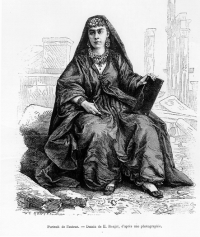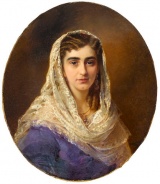Lydia Alexandrovna de Pashkov: Difference between revisions
| Line 30: | Line 30: | ||
We waited until night. She drew a circle and we went in it. We built a fire and put much incense on it. Then she said many spells. Then we put on more incense. Then she pointed with her wand at the monument and we saw a great ball of white flame on it. There was a sycamore tree near by; we saw many little flames on it. The jackals came and howled in the darkness a little way off. We put on more incense. Then Mme. Blavatsky commanded the spirit to appear of the person to whom the monument was reared. Soon a cloud of vapor arose and obscured the little moonlight there was. We put on more incense. The cloud took the indistinct shape of an old man with a beard, and a voice came, as it seemed, from a great distance, through the image. He said the monument was once the altar of a temple that had long disappeared. It was reared to a god that had long since gone to another world. "Who are you?" asked Mme. Blavatsky, "I am Hiero, one of the priests of the temple," said the voice. Then Mme Blavatsky commanded him to show us the place as it was when the temple stood. He bowed, and for one instant we had a glimpse of the temple and of a vast city filling the plain as far as the eye could reach. Then it was gone, and the image faded away. Then we built up big fires to keep off the jackals and went to sleep.<ref>Lydia A. de Pashkov, "Ghost Stories Galore: A Night of Many Wonders at Second Hand in the Eighth Avenue Lamasery." ''New York World'', April 21, 1878. Selection 3d. Quoted in [https://www.theosophical.org/component/content/article/23-online-resources/online-books/1705--sp-38236380 ''The Esoteric World of H. P. Blavatsky''] Chapter 3 by Daniel H. Caldwell.</ref> | We waited until night. She drew a circle and we went in it. We built a fire and put much incense on it. Then she said many spells. Then we put on more incense. Then she pointed with her wand at the monument and we saw a great ball of white flame on it. There was a sycamore tree near by; we saw many little flames on it. The jackals came and howled in the darkness a little way off. We put on more incense. Then Mme. Blavatsky commanded the spirit to appear of the person to whom the monument was reared. Soon a cloud of vapor arose and obscured the little moonlight there was. We put on more incense. The cloud took the indistinct shape of an old man with a beard, and a voice came, as it seemed, from a great distance, through the image. He said the monument was once the altar of a temple that had long disappeared. It was reared to a god that had long since gone to another world. "Who are you?" asked Mme. Blavatsky, "I am Hiero, one of the priests of the temple," said the voice. Then Mme Blavatsky commanded him to show us the place as it was when the temple stood. He bowed, and for one instant we had a glimpse of the temple and of a vast city filling the plain as far as the eye could reach. Then it was gone, and the image faded away. Then we built up big fires to keep off the jackals and went to sleep.<ref>Lydia A. de Pashkov, "Ghost Stories Galore: A Night of Many Wonders at Second Hand in the Eighth Avenue Lamasery." ''New York World'', April 21, 1878. Selection 3d. Quoted in [https://www.theosophical.org/component/content/article/23-online-resources/online-books/1705--sp-38236380 ''The Esoteric World of H. P. Blavatsky''] Chapter 3 by Daniel H. Caldwell.</ref> | ||
</blockquote> | </blockquote> | ||
Madame Blavatsky edited this account when it was published in [[The Theosophist (periodical)|''The Theosophist'']] in April, 1884. She added editorial notes explaining that "It was the Syrian ascetic who drew the circle, not she," and produced the other wonders.<ref>D. A. C. (F.T.S.), "A Night of Many Wonders" ''The Theosophist'' 5.55 (April, 1884), 167-169</ref> | |||
== Writings == | == Writings == | ||
Revision as of 14:22, 24 May 2020
UNDER CONSTRUCTION
UNDER CONSTRUCTION
Countess Lydia Alexandrovna de Pashkov (1845-19xx) was a Russian writer who was an early friend of Helena Petrovna Blavatsky. She wrote in French under the name Lydie Paschkoff.
Boris de Zirkoff wrote of her:
Russian woman-writer and traveller of the middle 19th century. she was neé Glinsky and had been first married to Teleshov. She travelled extensively in Egypt, Palestine and Syria, and was at one time correspondent of the Paris Figaro. Most of her works were written in French. Among them may be mentioned: La pension Vera Glinsky. – Un divorce en Russie. – Moeurs Russes (St. Petersburg, 1876-77). – En Orient, Drames et Paysages (St. Petersburg, 1879)....
H.P.B. and Countess de Pashkov travelled together for a while, and various curious phenomena took place at the command of H.P.B.
See H. S. Olcott, Old Diary Leaves I, 334-35, for a quotation from the New York World of April 21, 1878, and the Theosophist, Vol. V, April, 1884, p. 168.[1]
Theosophical historian John Patrick Deveney wrote:
Friendship with Madame Blavatsky
Around 1870-1872, Madame Blavatsky was in Odessa. She received a telegram from her friend Lydia that Agardi Metrovich had gone to Ramleh [now in Israel] and had become very ill from typhoid fever or possibly from poison. HPB hurried to Alexandria, Egypt by steamer to bring him back to her relatives in Odessa, but was too late.[3]
The Countess wrote of experiences with Madame Blavatsky while traveling in 1872 in Lebanon between Baalbek and the river Orontes. Their parties met and camped together in the desert.
There was a great monument standing there near the village of Dair Mar Maroon. It was between Lebanon and the Anti-Lebanon [Mountains]. On the monument were inscriptions that no one could ever read. Mme. Blavatsky could do strange things with the spirits, as I knew, and I asked her to find out what the monument was.
We waited until night. She drew a circle and we went in it. We built a fire and put much incense on it. Then she said many spells. Then we put on more incense. Then she pointed with her wand at the monument and we saw a great ball of white flame on it. There was a sycamore tree near by; we saw many little flames on it. The jackals came and howled in the darkness a little way off. We put on more incense. Then Mme. Blavatsky commanded the spirit to appear of the person to whom the monument was reared. Soon a cloud of vapor arose and obscured the little moonlight there was. We put on more incense. The cloud took the indistinct shape of an old man with a beard, and a voice came, as it seemed, from a great distance, through the image. He said the monument was once the altar of a temple that had long disappeared. It was reared to a god that had long since gone to another world. "Who are you?" asked Mme. Blavatsky, "I am Hiero, one of the priests of the temple," said the voice. Then Mme Blavatsky commanded him to show us the place as it was when the temple stood. He bowed, and for one instant we had a glimpse of the temple and of a vast city filling the plain as far as the eye could reach. Then it was gone, and the image faded away. Then we built up big fires to keep off the jackals and went to sleep.[4]
Madame Blavatsky edited this account when it was published in The Theosophist in April, 1884. She added editorial notes explaining that "It was the Syrian ascetic who drew the circle, not she," and produced the other wonders.[5]
Writings
Using the French name Lydie Paschkoff, she wrote novels, plays, and travelogues. These are some examples.
- Moeurs Russes. La princesse Vera Glinsky, la Nìanìa Marpha, Un divorce en Russie. Paris: Calmann Lévy, 1876.
- La pension Vera Glinsky – Un divorce en Russie. – Moeurs Russes St. Petersburg, 1876-77.
- En Orient, Drames et Paysages. St. Petersburg, 1879. Paris: Sandoz et Fischbacher, 1880. Available at data.bnf.fr
- La Princesse Vera Glinsky. Paris: C. Lévy, 1876. Available at data.bnf.fr
- La niania Marpha. Paris: C. Lévy, 1876.
- Un divorce en Russie.
- Moeurs Russes.
- Fleur de Jade. Paris: C. Lévy, 1890. Short stories set in China, Japan and the Far East.
- Cinderella. ca1892. Scenario for a ballet, commissioned by Lev Ianov.
- Le roman d'un grand-duc. Paris: Ed. Calmann-Levy, 1902.
- Revue Internationale
- "Promenade à Hong Kong et à Canton." October, 1884, pg. 289.
- "Chine et Russie." November, 1884, pg. 677.
- "Voyage a la Nouvell-Zemble." Tour du Monde. 1894. Pages 81-96. Written by N. Constantin Nossiloff and abstracted by Lydia Paschkoff.
Additional resources
- "Who Knew H.P.B. When?" by John Patrick Deveney. Published in Theosophical Encyclopedia, Theosophy Forward. March 4, 2020.
- The Esoteric World of H. P. Blavatsky Chapter 3 by Daniel H. Caldwell.
- Johnson, K. Paul. The Masters Revealed: Madam Blavatsky and the Myth of the Great White Lodge. State University of New York Press, 1994.
- Hodgson, Barbara. "Middle East: Desert Queens" in No Place for a Lady: Tales of Adventurous Women Travelers. Berkeley: Ten Speed Press, 2002. See this website.
Notes
- ↑ Boris de Zirkoff, "Pashkov, Countess Lydia Alexandrovna de" H. P. Blavatsky Collected Writings Volume I (Wheaton, Illinois: Theosophical Press, 1966), 521.
- ↑ John Patrick Deveney, "Who Knew H.P.B. When?" in Theosophical Encyclopedia, Theosophy Forward. March 4, 2020.
- ↑ H. P. Blavatsky, "Letter LXXVIII" The Letters of H. P. Blavatsky to A. P. Sinnett (London: T. Fisher Unwin, Ltd., 1925), 190-191.
- ↑ Lydia A. de Pashkov, "Ghost Stories Galore: A Night of Many Wonders at Second Hand in the Eighth Avenue Lamasery." New York World, April 21, 1878. Selection 3d. Quoted in The Esoteric World of H. P. Blavatsky Chapter 3 by Daniel H. Caldwell.
- ↑ D. A. C. (F.T.S.), "A Night of Many Wonders" The Theosophist 5.55 (April, 1884), 167-169

